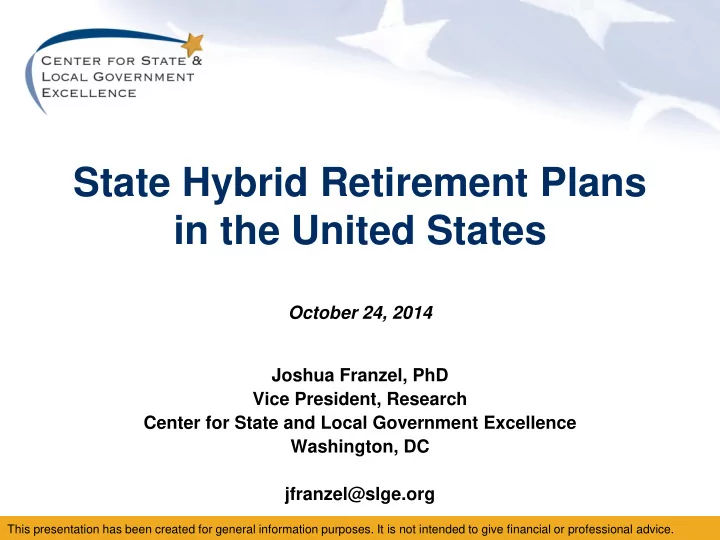

State Hybrid Retirement Plans in the United States October 24, 2014 Joshua Franzel, PhD Vice President, Research Center for State and Local Government Excellence Washington, DC jfranzel@slge.org This presentation has been created for general information purposes. It is not intended to give financial or professional advice.
The U.S. State Government Pension Plan Context • 50 states + about 90,000 local governments;14.4 million full time employees (2012) • About 4000 state and local government public employee retirement systems, 227 are state plans; 19.6 million active and inactive members and 9 million retirees (2012) • 86% of state workers have access to a defined benefit pension plan; 43% have access to a defined contribution plan (2014) • 82% of local workers have access to a defined benefit pension plan; 30% have access to a defined contribution plan (2014) • Note: about 30% of state and local workers do not participate in Social Security Sources: http://www2.census.gov/govs/cog/2012/2012_cog_map.pdf; http://www2.census.gov/govs/apes/12stlus.txt; http://www.census.gov/govs/retire/; http://www.nasra.org/socialsecurity; http://www.bls.gov/ncs/ebs/benefits/2014/ownership_government.htm
Plan Assets, as of Q2 2014 • Aggregate state and local defined benefit (DB) plan assets: – $3.7 trillion • Aggregate state and local defined contribution (DC) plan [403(b) ; 457] assets: – $538 billion Source: Board of Governors of the Federal Reserve System, Federal Reserve Statistical Release, ‘Financial Accounts of the United States’ (18/09/14)
State Hybrid Pension Plan Structures General State Employees* Hybrid Plan (DB/DC or Cash Balance) – mandatory or choice *Note: hybrid structures may be used for other employee groups (state and local) as well. Source: National Association of State Retirement Administrators (NASRA) and National Conference of State Legislatures (NCSL)
Overview of the Benefits, Risks, and Responsibilities of Different Employer-Sponsored Retirement Plans Source : Center for State and Local Government Excellence ‘What Are Hybrid Retirement Plans ?’ (2011)
The continued adoption of hybrid plans DB / DC Cash Balance • Indiana – 1955 • Nebraska – 2002 • Washington St. – 1996 • Kansas – 2012 • Ohio – 2003 • Kentucky - 2013 • Georgia – 2008 • Utah – 2010 • Rhode Island – 2011 • Virginia – 2012 • Tennessee - 2013 Source: National Association of State Retirement Administrators ‘Issue Brief: State Hybrid Retirement Plans’ (2013)
What are some reasons for the adoption and continued use of hybrid plans? • Indiana (implemented 1955) : [With the DB and Annuity Savings Account] “both the employer and member have funds at risk [… ] it has been part of the Indiana system for a generation .” • Nebraska (implemented 2002) : From 2000 Benefit Review Study, “Risk averse employees would benefit from the defined benefit form, while investment savvy employees can choose the defined contribution plan .” From 2014 NPERS newsletter, “Barron’s noted that one of the things that helps keep Nebraska’s pension liability low is that it has a cash balance plan.” • Tennessee (implemented 2013): “Reasons for Change…provide a sustainable pension plan going forward; Control employer pension cost; Control unfunded liabilities related to pensions; Provide a sufficient level of benefits for career employees to maintain a reasonable standard of living at retirement”. Links to sources: • “Understanding Indiana’s Largest Pension System ” (2014): http://www.in.gov/inprs/files/WhitePaper-UnderstandingINPRS.pdf • “Benefit Review Study of the Nebraska Retirement Systems” (2000): http://npers.ne.gov/SelfService/public/howto/publications/Buck2000.pdf • “Retirement News” NPERS (January 2014): http://npers.ne.gov/SelfService/public/newsletter/newsletterDC2014Jan.pdf • “Tennessee Consolidated Retirement System New Hybrid Pension Plan with Cost Controls ” http://treasury.tn.gov/tcrs/PDFs/NewHybridPresentation.pdf
Plan Contributions* DB / DC Cash Balance Employees Employees DB component: 4.5% 6% 0% 5%, {general range} DC component: Public Employers (State Gov.) 0% 15%, {general range} 4% 7.5% Public Employers (State Gov.) DB component: entire amount; amount needed aside from employee contribution; or up to a certain amount (example: 10%) DC component: *General State Employees 0% 5%, , {general range} Source: National Association of State Retirement Administrators ‘Issue Brief: State Hybrid Retirement Plans’ (2013)
Employee Retirement Income* • Cash Balance Plans: – Aggregated annual guaranteed returns (~4% 5.25%) are annuitized, with the potential for portions to be offered as a lump sum. • DB / DC – DB annual benefit = {1% 1.5%, generally} X years of service X final average salary – DC options: annuity; partial or full lump sum; periodic distributions; rollover; or deferral. *General State Employees Source: National Association of State Retirement Administrators ‘Issue Brief: State Hybrid Retirement Plans’ (2013)
Source: SLGE / NASRA ‘Effects of Pension Plan Changes on Retirement Security’ (2014)
Looking to the future… • What about “stacked” hybrid models? • Will hybrid plan adoption lead to offering core defined contribution plans in order to further reduce liabilities? • How well will hybrid structures position the retirement security of state employees in the USA if/when further changes are made to Social Security? See: SLGE/ANC Foundation/NAGDCA ‘The Evolving Role of Defined Contribution Plans in the Public Sector’ ( pg 6) (2012)
For more information on state hybrid (and other) retirement plans in the United States • Center for State and Local Government Excellence • National Association of State Retirement Administrators • National Conference of State Legislatures • U.S. Census Bureau : Annual Survey of Public Pensions: State and Local Data
Joshua Franzel, PhD Vice President, Research Center for State and Local Government Excellence Washington, DC jfranzel@slge.org This presentation has been created for general information purposes. It is not intended to give financial or professional advice.
Recommend
More recommend